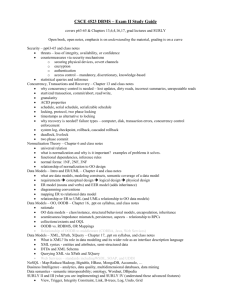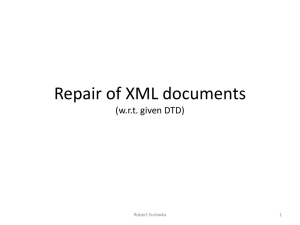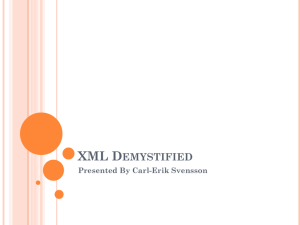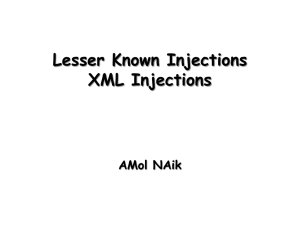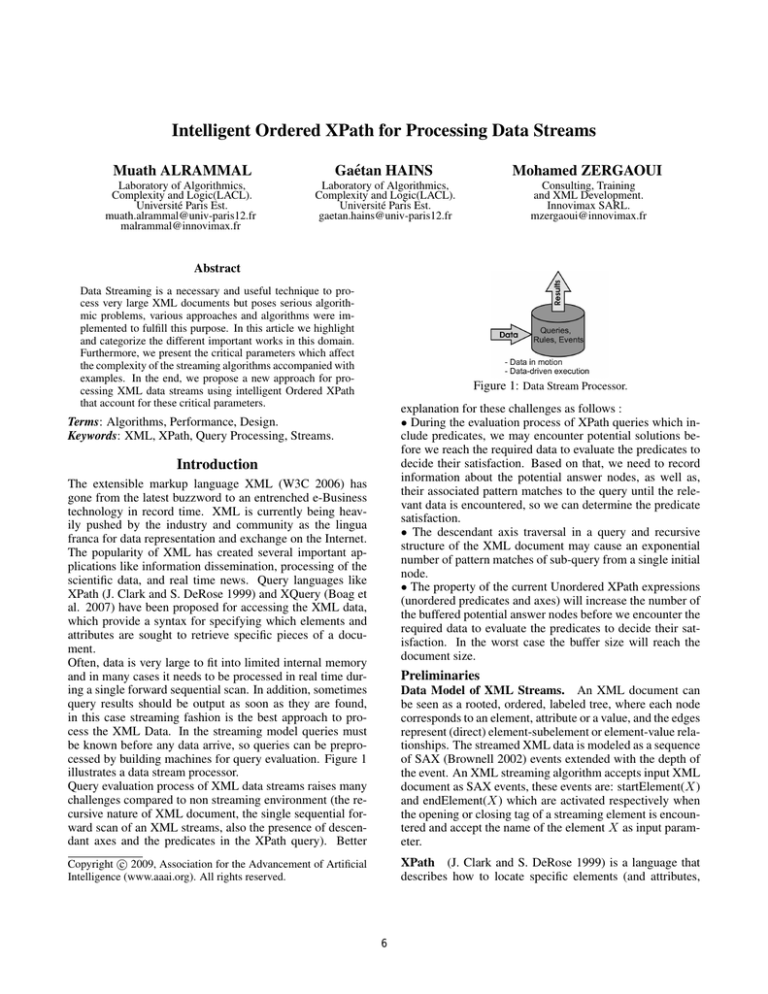
Intelligent Ordered XPath for Processing Data Streams
Muath ALRAMMAL
Gaétan HAINS
Mohamed ZERGAOUI
Laboratory of Algorithmics,
Complexity and Logic(LACL).
Université Paris Est.
muath.alrammal@univ-paris12.fr
malrammal@innovimax.fr
Laboratory of Algorithmics,
Complexity and Logic(LACL).
Université Paris Est.
gaetan.hains@univ-paris12.fr
Consulting, Training
and XML Development.
Innovimax SARL.
mzergaoui@innovimax.fr
Abstract
Data Streaming is a necessary and useful technique to process very large XML documents but poses serious algorithmic problems, various approaches and algorithms were implemented to fulfill this purpose. In this article we highlight
and categorize the different important works in this domain.
Furthermore, we present the critical parameters which affect
the complexity of the streaming algorithms accompanied with
examples. In the end, we propose a new approach for processing XML data streams using intelligent Ordered XPath
that account for these critical parameters.
Figure 1: Data Stream Processor.
explanation for these challenges as follows :
• During the evaluation process of XPath queries which include predicates, we may encounter potential solutions before we reach the required data to evaluate the predicates to
decide their satisfaction. Based on that, we need to record
information about the potential answer nodes, as well as,
their associated pattern matches to the query until the relevant data is encountered, so we can determine the predicate
satisfaction.
• The descendant axis traversal in a query and recursive
structure of the XML document may cause an exponential
number of pattern matches of sub-query from a single initial
node.
• The property of the current Unordered XPath expressions
(unordered predicates and axes) will increase the number of
the buffered potential answer nodes before we encounter the
required data to evaluate the predicates to decide their satisfaction. In the worst case the buffer size will reach the
document size.
Terms: Algorithms, Performance, Design.
Keywords: XML, XPath, Query Processing, Streams.
Introduction
The extensible markup language XML (W3C 2006) has
gone from the latest buzzword to an entrenched e-Business
technology in record time. XML is currently being heavily pushed by the industry and community as the lingua
franca for data representation and exchange on the Internet.
The popularity of XML has created several important applications like information dissemination, processing of the
scientific data, and real time news. Query languages like
XPath (J. Clark and S. DeRose 1999) and XQuery (Boag et
al. 2007) have been proposed for accessing the XML data,
which provide a syntax for specifying which elements and
attributes are sought to retrieve specific pieces of a document.
Often, data is very large to fit into limited internal memory
and in many cases it needs to be processed in real time during a single forward sequential scan. In addition, sometimes
query results should be output as soon as they are found,
in this case streaming fashion is the best approach to process the XML Data. In the streaming model queries must
be known before any data arrive, so queries can be preprocessed by building machines for query evaluation. Figure 1
illustrates a data stream processor.
Query evaluation process of XML data streams raises many
challenges compared to non streaming environment (the recursive nature of XML document, the single sequential forward scan of an XML streams, also the presence of descendant axes and the predicates in the XPath query). Better
Preliminaries
Data Model of XML Streams. An XML document can
be seen as a rooted, ordered, labeled tree, where each node
corresponds to an element, attribute or a value, and the edges
represent (direct) element-subelement or element-value relationships. The streamed XML data is modeled as a sequence
of SAX (Brownell 2002) events extended with the depth of
the event. An XML streaming algorithm accepts input XML
document as SAX events, these events are: startElement(X)
and endElement(X) which are activated respectively when
the opening or closing tag of a streaming element is encountered and accept the name of the element X as input parameter.
c 2009, Association for the Advancement of Artificial
Copyright Intelligence (www.aaai.org). All rights reserved.
XPath (J. Clark and S. DeRose 1999) is a language that
describes how to locate specific elements (and attributes,
6
Matching Nbr.
1
2
3
processing instructions, etc.) in a document. It operates on
the abstract, logical structure of an XML document, rather
than its surface syntax. This logical structure known as the
data model. XPath has a particular importance for XML
applications since it is a core component of many XML
processing standards such as XSLT (Clark 1999) or XQuery
(Boag et al. 2007). It has a natural subset (fragment) that
can be used for matching (testing whether or not a node
matches a pattern) (Berglund et al. 2007). Therefore, we
classify XPath based on its fragment as the following :
– XPath 2.0: it is the largest fragment of XPath, for precise
information about its grammar see (Berglund et al. 2007).
– XPath 1.0: it is a sub fragment of XPath 2.0, for precise
information about its grammar see (J. Clark and S. DeRose
1999) .
– Forward XPath: we define Forward XPath as the following: a sub fragment of XPath 1.0 consists of queries
that have: child, descendant axis. nodeTest which is either
element, wild chard. Predicate with (or, not, and). And
arithmetic.
Nodes of Structural Matching
A1 B7 C8 K8
A2 B7 C8 K8
A4 B8 C8 K8
Table 1: Nodes of Structural Matching of Q in D
of nodes e1 , ..., er in D, such that 1) all the nodes lie on
the same path (root-to-leaf), and 2) all the nodes match
structurally the sub-pattern (q). To facilitate and clarify
the meaning of recursion, figure 3 illustrates the depth of
document D w.r.t the query Q //A//B[.//C]/K .
Figure 3: Recursion depth of D w.r.t Q.
The single line edges represents child (‘/’), the double line
edges represents descendant(‘//’), single dashed line represents [./node()], double dashed line represents [.//node()]
and the result node which is in this example the shaded
node K.
It is obvious from figure 3 that node C is not on the main
path, this is why we do not consider it as a rq . If we have a
look at table 1, both nodes A and B satisfy the definition of
rq . Actually, rA = 3 represented by ( A1 , A2 , A4 ), while rB
= 2 represented by (B7 , B8 ).
In our example figure 3 the used XPath expression can
be considered a Simple XPath, for more Complex XPath
expression, see figure 5, it benefits from the grammar of
figure 2. Moreover, our query is Unordered (axes and
predicate position) ( note that, further explanations about
Ordered and Unorderd XPath can be found in sections 4 and
5.) because node C in Q can be before node K or after.
For a precise understanding of Forward XPath, we illustrate its grammar in figure 2. A location path is a structural
pattern composed of sub expressions called steps. Each step
consists of an axis (defines the tree-relationship between the
selected nodes and the current node), a node-test (identifies
a node within an axis), and zero or more predicates (to further refine the selected node-set). An absolute location path
starts with a ‘/’ or ‘//’ and a relative location path starts with
a ‘./’ or ‘.//’.
Path := GenericPath | GenericPath / AttributeStep
| AttributeStep
GenericPath := GenericStep
| GenericPath GenericStep
GenericStep := Axis NodeTest | Axis NodeTest ’[’ Predicate ’]’
AttributeStep := ’@’ NodeTest| ’@’ NodeTest ’[’ Predicate ’]’
Axis := ’/’ | ’//’
NodeTest := name | ’*’
Predicate := PredicatePath | PredicatePath CompOp constant
| Predicate ’and’ Predicate
| Predicate ’or’ Predicate
| ’not(’ Predicate ’)’
CompOp := ’=’ | ’!=’ | ’>’ | ’>=’ | ’<’ | ’<=’
PredicatePath := ’.’ GenericPath | ’.’ GenericPath / AttributeStep
| AttributeStep
Figure 2: Grammar of Forward XPath.
Our restriction to the downward axes in our XPath fragment is not absolute, we could cover more general axes than
‘/’, ‘//’ by using rewrite rules as shown in Olteanu paper
(Olteanu et al. 2002) to reduce more general axis operations
to forward ones.
Concerning query evaluation process, different strategies
and streaming algorithms were implemented for this purpose, we can categorize some of them based on the time of
predicates evaluation in queries as follows: 1) streaming algorithm evaluates the predicates only when the closing tags
of the streaming elements are encountered. 2) Eager streaming algorithm evaluates the predicates as soon an atom in a
predicate is evaluated to true.
Document Depth dD is the length of the longest root to
leaf path in the tree. In our example in figure 3, document
depth is the path from root node A1 to the leaf node K8 .
The rest of the paper is organized as follows: In section
2, we present the related work, a survey about the different
streaming algorithms and their streamable XPath fragments.
In section 3, we examine and compare the XPath fragments
of the streaming algorithms in the related work (section 2)
with the fragment of Forward XPath. Next, in section 4 we
explain the critical parameters that affect the complexity of
the current streaming algorithms, furthermore, we present
our motivations for a new approach. We propose a new approach for processing XML Data streams in section 5. After
that, we conclude in section 6.
Recursion in XML Data occurs frequently in XML data
in practice (Choi 2002), where some elements with the
same name are nested on the same path in the data tree. In
(Bar-Yossef, Fontoura, and Josifovski 2004), they define the
recursion depth of an XML data tree D w.r.t the query node
q in Q, denoted by rq as : the length of the longest sequence
Related Work
A large amount of work has been conducted to process XML
documents in streaming fashion. The different approaches
7
to evaluate XPath queries on XML data streams can be categorized by the processing approach they use. Most of them
are automata based [XPush (Gupta and Suciu 2003), XSQ
(Peng and Chawathe 2003), SPEX (Olteanu, Kiesling, and
Bry 2003), XMLTK (Avila-Campillo et al. 2002)] or Parse
tree based [(Chen, Davidson, and Zheng 2006),(Barton et
al. 2003),(Bar-Yossef, Fontoura, and Josifovski 2004),(Gou
and Chirkova 2007)].
In (Gupta and Suciu 2003) authors propose to lazily construct a single deterministic pushdown automata (a special
deterministic stack machine) which is called ”XPush Machine” for a given XPath filters. The input is a series of
SAX events and the output is a set of filters that match the
processed document. An application example for this work
is XML message brokers.
AFilter(Candan et al. 2006) is an adaptable XPath query
evaluation approach that needs a base memory requirement
which is linear in query and data size. If more memory is
provided to AFilter, it uses the remaining main memory for
a caching approach to evaluate queries faster than with only
the base memory. AFilter is mainly based on a lazy DFA and
it supports wildcards, but does not support predicate filters.
Similar to XPush (Gupta and Suciu 2003), it is designed to
evaluate a large set of queries.
In (Chen, Davidson, and Zheng 2005) authors aim to achieve
polynomial time complexity in both data and query size for
evaluating XPath queries on XML data stream, based on
that, they propose ViteX System that is composed of four
modules: 1) XPath parser. 2)TwigM builder. 3) SAX parser.
4) As SAX events stream in, TwigM changes its state according to the current state and the input event, then it computes a set of XML fragments as solutions to Q. The idea is
to use an encoding technique, therefore, TwigM uses a compact data structure to encode patterns matches rather than
storing them explicitly which is a memory advantage. After that, it computes query solution by probing the compact
data structure in Lazy fashion without computing pattern
matches.
(Zhang and Zou 2006) introduces a streaming XPath algorithm (QuickXScan). It is based on the principles similar to
that of attribute grammars. Authors, model an XPath query
with a query tree. In the structural join based algorithms,
there is a nice solution of using compact stacks to represent
a possibly combinatorial explosive number of matching path
instantiations with linear complexity like (Jiang et al. 2003),
therefore, QuickXScan extends the idea of compact stacks
in a technique called matching grid, which is used also in
(Ramanan 2005).
In TurboXPath(Josifovski, Fontoura, and Barta 2004) the input query is translated into a set of parse trees. Whenever a
matching of a parse tree is found within the data stream, the
relevant data is stored in form of a tuple that is afterward
evaluated to check whether predicate and join conditions are
fulfilled. The output is constructed out of those tuples of
which have been evaluated to true.
XSQ (Peng and Chawathe 2003) and SPEX (Olteanu, Kiesling, and Bry 2003) propose a method for evaluating XPath
queries over streaming data to handle closures, aggregation
and multiple predicates. Their method is designed based
on hierarchical arrangement of push-down transducers augmented with buffers. Automata is extended by actions attached to states, extended by a buffer to evaluate XPath
queries. The main idea is a non-deterministic push-down
transducer (PDT) that is generated for each location step in
an XPath query, these PDTs are combined into a hierarchical
pushdown transducer in the form of a binary tree. XSQ eagerly evaluates queries and it is fully implemented thus give
us the possibility to compare our algorithms with it.
The authors of (Chen et al. 2004) present a model of
data processing for information system exchange environment. It consists of a simple and general encoding scheme
for servers, and algorithms of streaming query processing
on encoded XML stream for data receivers with constrained
computing abilities ”binary encoding”. The EXPedite query
processor takes an encoded XML stream and an encoded
XPath query as input, and outputs the encoded fragment in
the XML stream that matches the query. The idea of the
query processing algorithm is taken from different proposed
techniques (DeHaan et al. 2003), (Grust 2002) for efficient
query evaluation based on XML node labels for XML data
stored in the database.
In (Stefan Böttcher and Rita Steinmetz 2007) a SAX
Based approach is introduced to evaluate the XPath queries
that support all axes of Core XPath. Each input query is
translated into an automaton that consists of only four different types of transitions. The small size of the generated
automata allows for a fast evaluation of the input XML data
stream within a small amount of memory. They have implemented a prototype called XPA. The query processor decomposes and normalizes each XPath query, such that the
resulting path queries contain only three different types of
axes, and then converts them into lean XPath automata for
which a stack of active states is stored. The input SAX
event stream is converted into a binary SAX event stream
that serves as input of the XPath automata.
The approach presented in (Chen, Davidson, and Zheng
2006) uses a structure which resembles a parse tree with
stacks attached to each node. These stacks are used to store
XML nodes that are solutions to the parse tree nodes subquery (or to store XML nodes that are candidates for a solution in case of predicate filters).
In (Gou and Chirkova 2007) authors propose two algorithms
to evaluate XPath over streams, they are 1) Lazy streaming algorithm(LQ). 2) Eager streaming algorithm(EQ). Algorithms accept XML document as a stream of SAX events.
The used fragment of XPath called Univariate XPath. The
goal of both algorithms is to prove that Univariate XPath
(Bar-Yossef, Fontoura, and Josifovski 2004) supports the
parent and the ancestor axes in addition to that Forward
XPath axes. It builds parse tree which is used to ‘predict’
the next matching nodes and the level in which they have to
occur, e.g. consider the query //C/D and a matching of C in
level 3. Then the next interesting matching would be a node
D in level 4.
8
Comparison between Forward XPath and the XPath fragments of the streaming algorithms
No.
Algorithm/Tool
Plus(Forward XPath)
Minus(Forward XPath)
1
XPush Machine
- nodeTest : text()
2
TurboXPath
- XQuery features including for,
- Predicate without
let, and where.
(or,not)
- Functions : user defined functions
(UDFS) they are XMLContains ,
XMLExtract, XMLTable .
- Parent, and ancestor axes.
3
XSQ
- Arithmetic. (they allow contains)
- Predicate without
- Functions : sum(), count()
(or, not, and).
4
TwigM
- Predicate without
(or,not).
5
XPA
- Supports all axes
-Predicate without
of core XPath
(or, not, and).
6
QuickXScan
- Functions : number(),
count(), sum()
7
EXPedite
- No wild chard
-Predicate without
(or, not, and).
8
AFilter
- No predicates
9
XMLTK
- No predicates
10
Univariate XPath
- Predicate without
(or,not).
11
N-DFA ,
-Predicate without
shared NFA
( or, not, and).
Table 2: Comparison between Forward XPath and the XPath
Figure 4: Streamable XPath Fragments.
Fragments of the Streaming Algorithms.
mar of Forward XPath (predicate with or, not) e.g. XSQ
(Peng and Chawathe 2003), XPA (Stefan Böttcher and
Rita Steinmetz 2007).
• 1/11 of the streamable XPath fragments support specific
grammar of XPath 2.0 ( XQuery features for, let, where)
but they do not support all the grammar of XPath 1.0 and
Forward XPath, e.g. TurboXPath (Josifovski, Fontoura,
and Barta 2004).
• 7/11 of the streamable XPath fragments, do not support
predicates with (or, not).
• All algorithms use Unordered XPath.
Therefore, in comparison to all these approaches, we propose the notion of Intelligent Ordered and Oriented Forward
XPath (section 5) taking in consideration the critical complexity parameters that are explained in the next section.
can be efficiently evaluated in O(|D||Q|) time in the streaming environment and to show that algorithms are not only
time-efficient but also space-efficient. Based on their experiments, both LQ and EQ algorithms show very similar time
performance in practice. In non recursive ( There are no nodes
of a certain type can be nested in another nodes of the same type.
) cases, LQ and TwigM has the same buffering space costs,
as well as, EQ and XSQ has the same case. EQ achieves
the optimal buffering space performance, therefore it can be
considered as the best performance representation between
algorithms in the state of the art of their paper.
In the next section, we study the the different XPath fragments of the streaming algorithms and compare them with
the fragment of Forward XPath.
Comparison Process between Forward XPath
and the XPath Fragments of the Streaming
Algorithms.
Critical Complexity Parameters
Usually, the caching space costs of stream-querying algorithms depends on the number of elements cached in the
run-time stack(s). It is bounded by the maximum document
depth dD when queries do not involve *-nodes or the same
name nodes( Figure 5 is an example of a query that involves
*-nodes or the same name nodes which increases the buffer
size and processing time) and does not exceed (|Q|.dD ) in
the worst case. Also, we can measure the CPU time performance of stream-querying algorithms by the following equation:
In the related work that is mentioned above, we have examined the different fragments used of the algorithms (see table
2) and compared them with the fragment of Forward XPath
(figure 2). The purposes of this comparison are as follows:
• Knowing the relationships between the fragments of the
different algorithms.
• Estimate the boundaries or the frontiers area of the
streamable fragment of XPath.
For further explanation, figure 4 illustrates the intersection
between the different algorithms, and the boundaries of the
streamable XPath fragment.
The red dashed line represents the boundary of the streamable XPath fragment. After analysis the different XPath
fragments in table 2 , we have noticed the following :
• 6/11 of the streamable XPath fragments are sub fragments of Forward XPath e.g. Univariate XPath (Gou and
Chirkova 2007), AFilter (Candan et al. 2006).
• 3/11 of the streamable XPath Fragments can support specific parts of XPath 1.0 grammar (reverse axis, or functions). In the same time they do not support all the gram-
Tp = tall − tinput − toutput
where tall is the total running time, tinput is the reading time
usually from the disk into memory also parsing the XML
document, and toutput is the taken time to output the result
nodes from the memory to the disk. In practice, complexity
depends on many parameters, we explain them as follows :
Structure of XML Document Data Documents may
have varied structures, for instance, shallow XML documents (Wide) that do not include recursive elements (figure 6) . In this case the caching space costs of the streamquerying algorithm is almost negligible. An example for this
9
Structure
Data Size
Nbr. of nodes
Max./Avg Depth
XMark
Wide
and Shallow
113MB
1666K
12/5.5
Book
Semi deep+
and recursive
12MB
114K
22/19.4
TreeBank
narrow deep
and recursive
82MB
2437K
36/7.6
the predicates of A is evaluated to be true the moment element < F > arrives. Thus, each < Ci > can be flushed
as a query result the moment it arrives and does not need to
be buffered at all. Obviously this will improve the buffering
space performance.
Table 3: Different Dataset Structures.
type of XML document is XMark (Schmidt ) which is a famous benchmark dataset that allows users and developers to
gain insights into the characteristics of their XML repositories. See table 3 which indicates the maximum depth of this
dataset that reaches 12 (not deep), and it has a large data size
113MB.
Others documents are semi deep and recursive e.g. Book
dataset (Diaz and Lovell ), actually it is a synthetic dataset,
generated using IBM’s XML generator, based on real DTD
from W3C XQuery use case. As we can see from table 3, it
has a size of 12 MB which is not enormous and a maximum
depth that reaches 22 which is quite deep comparison to its
size. It includes only one recursive element named section.
In fact, different sections node can be nested on the same
path in the data tree, therefore this kind of dataset(semi deep
and recursive) increases the buffering space and processing
time. We can find also documents with narrow deep structure, e.g. TreeBank (Suciu ), here one can recognize the
structure of the document from the maximum depth in table
3, it is 36, moreover, the average depth which is 7.8. The
existence of these properties in the document are strongly
related to the algorithmic complexity of stream processing.
Figure 6: Lazy and Eager Approaches.
It is clear that Eager strategy has a better buffering space
than the Lazy one, but both of them do not handle the problem of descendant axis and the complexity of Unordered
XPath expressions. Note that figure 6 is an example of a
wide dataset.
Motivation Examples for New Approach
Descendant Axis Problem In the parse tree approach, an
XPath query specifies a twig pattern Q to navigate an XML
Document D. Document size |D| is the number of elements in the D, while query size is the number of nodes
in Q. Query nodes are three types, we have the result
node which specifies the output of the XPath. Axis nodes
which are all non-result nodes on the main path of Q, that
means on the path from the root to the result node. Finally, Predicate nodes which are all other nodes. For example let us suppose that we have the following XPath
//A[./E]/B[./F ]//C[./G/Iand//H]/D[./J] , which is illustrated
in figure 7.
The XPath Expression (Recursion) Simple XPath expressions may not require huge buffering space size, see figure 3. On the other hand, the existence of descendant axis
‘//’, the wildcard * or the same name node in the expression
that is used to search deep and recursive XML document will
increase the buffering size and processing time enormously,
because we will be forced to buffer large number of potential
answer nodes. An example of this XPath expression type is
//A[./B//∗]// ∗ [./A]/K see figure 5. We call this expression
Complex XPath.
Figure 7: Twig Pattern of an XPath Query Q.
An important question is the order of the node H, actually
in our example node H can be in different orders, might be
before nodes G, I or after. In the worst case node H can
be after node D, thus will increase the complexity (buffer
space and processing time) remarkably, due to the fact that
our XPath expression is Unordered (axes and predicates position).
Figure 5: Complex XPath Expression.
Query Evaluation Strategy The used strategy to evaluate the XPath expression may affect the size of the buffering
space B and processing time. Note that B is measured by
the maximum number of potential answer nodes buffered at
a time during the running time. B might reach document
size |D| in the worst case. For example, let us consider that
we have the document D and the query Q //A[./F ]/C as it is
shown in figure 6. In the Lazy approach, B = n or in other
words B = |D| since the predicate of A is not evaluated until < /Ai > arrives. In this case all nodes starting from C1
to Cn have to be buffered, which will increase the buffering
size remarkably. While in Eager approach B = 0 because
Attributes Order Problem Another important point is the
child and attribute axes. Both axes can not be handled in a
similar way. The reason again relates to elements order. A
simple example that prove the difference between both axes
is the following: let us consider that we have the following
XML Documents (f,g), figure 8.
<A m="male" f="female">
<B> </B>
<C> </C>
</A>
XML Document f
<A f="female" m="male">
<C> </C>
<B> </B>
</A>
XML Document g
Figure 8: XML Documents
10
Obviously, in both documents attributes are unordered, just
because attribute specification markup is unordered, which
implies, the order of attribute specifications in a start-tag or
empty-element tag is not significant (W3C 2006). While it
is not the same case for elements. The order of elements in
an XML document as determined by XML syntax is called
document order. One can have other types of orders such
as alphabetical and numerical, but document order is determined solely by XML syntax. Both (Bar-Yossef, Fontoura,
and Josifovski 2004) and (Gou and Chirkova 2007) do not
treat explicitly the attribute axis @, considering that it can
be handled in a way similar to the child axis. This consideration affects the evaluation process of the XPath over the
XML data stream.
maintaining its original properties.
In this article we define Ordered XPath as the following: a
language that treats an XML document as an ordered tree to
locate specific elements (and attributes, processing instruction, etc... .) considering that it has ordered axes and predicate position.
The grammar of Ordered XPath is almost the same as
the grammar of Forward XPath in figure 2. The only difference is ordered axes and predicate position. Concerning ordered axes we use a Dewey Path as shown in figure
9. The predicate positions can be constrained as follows
[[.//node()[@order]] > [.//node()[@order]]] , it means the Dewey
path of the first node is larger than the Dewey path of the second node. In other words the first node is after the second
node in the document information order. For better understanding please see the examples of section (5.1).
Buffering Space Size Explosion Launching a Complex
Unordered XPath expression that contain *-nodes and the
same name nodes to search a narrow deep recursive XML
Document affects the complexity by increasing both processing time and buffering space incredibly. In the worst
case, it may result in explosion of the buffering space size.
An example for that is launching Complex XPath expressions to search the dataset Treebank (table 3) using XSQ
(Peng and Chawathe 2003). In our case, XSQ may report too
many path combinations and terminate the searching process. While using an Ordered XPath expression will reduce
remarkably the potential answer nodes which is a very good
complexity investment for both time processing and buffering space size.
• Metadata Schema To support Ordered XPath queries,
the order information of nodes must be captured by the
schema to process these queries efficiently. Figure 9 illustrates the information order of document D (ordered axes).
Metadata Schema and Intelligent Ordered
XPath
Figure 9: Document Information Order
The purpose of our metadata schema is to help us locate the
part of XML documents we search by providing information
about the structure and the content of this document. Thus
we can profit from Ordered XPath property to efficiently retrieve the required data that correspond to the XPath expression.
• Intelligent Ordered XPath. In our state of the art we
found many techniques and algorithms to process and evaluate XPath expressions over XML data streams. These techniques vary in the used fragment of XPath, but all of them
use Unordered XPath expression. In section we introduced
very important motivations that explain the idea and complexity cost of Ordered XPath. Based on that observation,
we define Intelligent Ordered XPath as the following : an
XPath language that profits from two main features:
– Ordered XPath (ordered axes predicate position).
– Metadata Schema (metadata document structure).
in order to improve the buffering space and the processing
time.
Next we will present examples to highlight the difference
between using Intelligent Ordered XPath and Unordered
XPath.
The previous observations encouraged us to search a new,
preemptive approach to optimizing query processing in
streaming mode. The idea consists in providing metadata
with structural data and search-orienting information. This
information is either provided by the author of the query
or accumulated over successive queries. The concept is
supported by our first experiments in (Alrammal, Hains,
and Zergaoui 2009).
• Metadata is data associated with objects which relieves
their potential users of having full advance knowledge of
their existence or characteristics. We can define metadata
as a systematic method for describing resources and thereby
improving access to them. If a resource is worth making
available, then it is worth describing it with metadata, so as
to maximize the ability to locate it.
In our case, the syntax of metadata can be as follows :
<A4 order=”2.2.1.1” subTreeSize=”4” ... /A> in this example, the
attribute order provides us with the path from the root to
nodeA4 (Dewey Path), while the attribute subTreeSize gives
size of the subtree of the node A4 . See figure 9.
• Ordered XPath has been investigated before in the relational databases. (Choi et al. 2007) Presents a novel
approach to efficiently evaluate Ordered XPath queries in
relational databases. A scheme extending SUCXENT++
(Prakash, Bhowmick, and Madria 2006) was proposed to
support the processing of ordered axes and predicates while
Intelligent Ordered XPath vs. Unordered XPath
Comparison examples between Intelligent Ordered XPath
and Unordered one are as follows:
Example 1: let us suppose that we use the dataset TreeBank which is narrow and deep( table 3) and Lazy strategy
of figure 6. Though Eager has a better performance on this
11
example, we use Lazy in our example to illustrate the importance of Ordered XPath. By using Unordered XPath, the
buffering space will be in the worst case B = |D| = 2437.
Now using Intelligent Ordered XPath which is provided
in information as follows (start after node order 1000 because interesting potential answer nodes are after node order
1000), this will reduce the worst case of buffering size to be
B=1437. Such information may be available for a user who
can grossly locate the target of the query, for example ”the
section we should search is somewhere after page number
1000 in the book”.
In the same example imagine that Intelligent Ordered XPath
was provided in information as follows (always search to the
right of the context node), here buffering size can be reduced
remarkably because we will avoid buffering any potential
answer node lie to the left of the context node.
Figure 10: SDI
– XPath complexity: in both cases Simple XPath see figure
3 or Complex XPath see figure 5, the buffering size performance will be improved due to the property of the ordered
(axes and predicates position) of Intelligent Ordered XPath,
while it is not the same case for Unordered XPath.
– XML document structures: Intelligent Ordered XPath can
be efficient with the different XML document structures. For
example, the wide dataset like XMark, or the narrow recursive like TreeBank, as we saw in the examples of section .
– Query evaluation approach: it is no less efficient as the
various used approaches of query evaluation like Lazy and
Eager. In the same example of section , we explained how
to avoid the worst case of buffering size with Lazy. Note
that Eager may has a better performance. Therefore, using
Intelligent Ordered XPath with the Eager will also result in
a better performance than using it with the Lazy. Moreover,
saving the space comes as we have shown by reducing the
buffering process. Thus, for a given strategy Eager/Lazy,
ordered( axis and predicate position) will decrease time by
avoiding unnecessary buffering operations.
We can conclude based on the previous examples, that the
efficiency of Intelligent Ordered XPath does not only improve the buffering space, but also the processing time.
Example 2: figure 9 represents an XPath expression
and an XML document with (information
order).
Case(1): if XPath is provided in information as follows(
start at the axis order 2 of node A) then, the syntax of XPath
expression that respects the grammar of Ordered XPath will
be: //A[@order = ”2”]//B[.//C]/K .
in this case, based on figure 9 we do not need to buffer the
following nodes: B4 , B5 , C1 though they would otherwise
match the query.
Case(2): XPath is provided in further information as
follows: ( start at the axis order 2 of node A, and node C
should be after node K) then; the syntax will be:
//A//B[.//C]/K
//A[@order = ”2”]//B[[.//C[@order]]>[./K[@order]]]/K
in Case(2) we know that the position of the predicate node
C is to the right(after) of the result node K. Thus, we avoid
to evaluate the predicate node C5 which is time investment.
Note that Case(2) has the same (ordered axes) as Case(1),
while Case(1) has not (ordered predicate position) as in
Case(2).
Example 3: Figure 10 is an example application of XML
streaming quoted in (Gou and Chirkova 2005). It concerns
Selective Dissemination of Information (SDI) whereby publishers and subscribers exchange flat XML documents
through a filtering system in charge of realizing queries. SDI
is an instance of event processing because stream querying
algorithm is triggered by the arrival of a new data stream.
Our proposed scheme is applicable to such a system in the
following manner: Metadata helps to improve the algorithm
performance, and conversely collected performance data is
fed back into the system to enrich the metadata thus narrowing future queries as explained in our technical report
(Alrammal, Hains, and Zergaoui 2009).
Conclusion
In this article we introduced a survey about different approaches used to evaluate XPath expressions over XML data
Streams, we categorized the different works by the processing approach they use into two categories. First, Automata based like [XPush (Gupta and Suciu 2003), XSQ
(Peng and Chawathe 2003), SPEX (Olteanu, Kiesling, and
Bry 2003), XMLTK (Avila-Campillo et al. 2002)]. Second, Parse tree based like [(Chen, Davidson, and Zheng
2006),(Barton et al. 2003),(Bar-Yossef, Fontoura, and Josifovski 2004),(Gou and Chirkova 2007) ]. Furthermore, we
estimated the boundary area of the streamable XPath fragments of the streaming algorithms, to the best of our knowledge we are the first who did this process. In addition, we
introduced variant examples to explain the critical complexity parameters of the streaming algorithms, like query evaluation strategy, the XPath expression (recursion) and the
structure of XML document. Based on that, the notion of
the intelligent Ordered XPath for processing efficiently large
XML data streams was proposed to accounts for these critical parameters.
Advantages of Intelligent Ordered XPath
It is true that sometimes by restricting the query to Intelligent Ordered XPath, our document may not satisfy the
query. In this case relaunching the query with new information is necessary. In the same time, there are many advantages of Intelligent Ordered XPath that account for the
critical complexity parameters. They are summarized as the
following :
12
Future Work
Clark, J.
1999.
XSL Transformations XSLT,
http://www.w3.org/tr/xslt.
DeHaan, D.; Toman, D.; Consens, M. P.; and Ozsu, M. T.
2003. A Comprehensive XQuery to SQL Translation using
Dynamic Interval Encoding . SIGMOD.
Diaz, A., and Lovell, D. Book : IBM XML Dataset,
http://www.alphaworks.ibm.com/tech/xmlgenerator.
Gou, G., and Chirkova, R. 2005. XML Query Processing: A survey. Technical Report -Department of Computer
Science, North Carolina State University.
Gou, G., and Chirkova, R. 2007. Efficient Algorithms for
Evaluating Xpath over Streams. Proceedings of the 2007
ACM SIGMOD international conference on Management
of data 269 – 280.
Grust, T. 2002. Accelerating XPath Location Steps . Proceedings of the 2002 ACM SIGMOD international conference on Management of data 109 –120.
Gupta, A. K., and Suciu, D. 2003. Stream Processing of
XPath Queries with Predicates. SIGMOD 219 – 430.
Ives, Z.; Halevy, A.; and Weld, D. 2002. An XML Query
Engine for Network-Bound Data. VLDB 380 – 402.
J. Clark and S. DeRose. 1999. XML Path Language
(XPath), http://www.w3.org/TR/xpath .
Jiang, H.; Wang, W.; Lu, H.; and Yu, J. 2003. Holistic
Twig Joins on Indexed XML Documents*. Proceedings of
the 29th VLDB Conference, Berlin, Germany.
Josifovski, V.; Fontoura, M.; and Barta, A. 2004. ‘Querying XML Streams . 197 – 210.
Olteanu, D.; Meuss, H.; Furche, T.; and Bry, F. 2002.
XPath: Looking Forward. In workshop on XML-Based
Data Management, Springer LNCS 2490.
Olteanu, D.; Kiesling, T.; and Bry, F. 2003. An Evaluation
of Regular Path Expressions with Qualifiers against XML
Streams . ICDE 702 – 704.
Peng, F., and Chawathe, S. S. 2003. XPath Queries on
Streaming Data . SIGMOD.
Prakash, S.; Bhowmick, S. S.; and Madria, S. 2006. Efficient Recursive XML Query Processing Using Relational
Database Systems. Data and Knowledge Engineering.
Ramanan, P. 2005. Evaluating an XPath Query on a
Streaming XML Document. COMAD, India.
Schmidt, A.
Xmark:An XML Benchmark Project,
http://monetdb.cwi.nl/xml.
Stefan Böttcher and Rita Steinmetz. 2007. Evaluating
XPath Queries on XML Data Streams . BNCOD 101–113.
Suciu,
D.
Treebank:XML data repository,
http://www.cs.washington.edu/research/xmldatasets.
W3C. 2006. Extensible Markup Language (XML) 1.0
(fourth edition).
Zhang, G., and Zou, Q. 2006. QuickXScan: Efficient
Streaming XPath Evaluation. International Conference on
Internet Computing 249–255.
We are currently designing an algorithm for processing Ordered XPath, and when implemented its performance will
be compared with stream-querying algorithms like (Gou
and Chirkova 2007), XSQ (Peng and Chawathe 2003) and
(Chen, Davidson, and Zheng 2005).
In (Alrammal, Hains, and Zergaoui 2009) we show performance measurements for token search depending on document structure and size. The results are analyzed to estimate possible gains from the scheme we suggested above.
To minimize the effort in providing ordering information in
the metadata we will investigate evolving query algorithms
that accumulate the statistics of query ordering for a given
document, thus gradually improving performance over successive queries.
Acknowledgments
The first author thanks Innovimax for doctoral funding under a CIFRE scheme of the French government.
References
Alrammal, M.; Hains, G.; and Zergaoui, M. 2009. Performance Measurements towards the Optimization of Stream
processing for XML Data.
Avila-Campillo, I.; Green, T. J.; Gupta, A.; Onizuka, M.;
Raven, D.; and Suciu, D. 2002. XMLTK:An XML Toolkit
for Scalable XML Stream Processing. Proc. PLANX (10).
Bar-Yossef, Z.; Fontoura, M.; and Josifovski, V. 2004. On
the Memory Requirements XPath Evaluation over XML
Streams. PODS. 177 – 188.
Barton, C.; Charles, P.; Goyal, D.; Raghavachari, M.; Fontoura, M.; and Josifovski, V. 2003. Streaming XPath Processing with Forward and Backward Axes. ICDE 455–466.
Berglund, A.; Boag, S.; Chamberlin, D.; Fernández, M.;
and Michael. 2007. XML Path Language (XPath 2.0),
http://www.w3.org/tr/xpath20.
Boag, S.; Fernández, M. F.; Florescu, D.; Robie, J.; and
Siméon, J. 2007. xquery 1.0: An XML Query Language.
Brownell, D. 2002. SAX2.
Candan, K. S.; Hsiung, W.; Chen, S.; Tatemura, J.; and
Agrawal, D. 2006. AFilter: Adaptable XML Filtering with
Prefix-Caching and Suffix-Clustering. VLDB 559 – 570.
Chen, Y.; Davidson, S. B.; Mihaila, G. A.; and Padmanabhan, S. 2004. Expedite : A System for Encoded XML
Processing . CIKM 108–117.
Chen, Y.; Davidson, S. B.; and Zheng, Y. 2005. ViteX : a
Streaming XPath Processing System. Proceeding of ICDE
1118 – 1119.
Chen, Y.; Davidson, S. B.; and Zheng, Y. 2006. An Efficient XPath Query Processor for XML Streams. Proc.
22nd ICDE .
Choi, B.; Leonardi, E.; Seah, B.-S.; Widjanarko, K. G.;
and Bhowmick, S. S. 2007. Efficient Support for Ordered
XPath Processing in Tree-Unaware Commercial Relational
Databases. Springer.
Choi, B. 2002. What are real DTDs like? International
Workshop on the Web and Databases.
13


